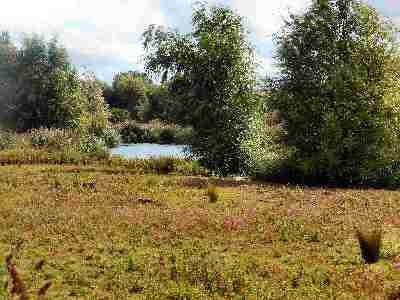Railway Quarter Trail - RAILWAY TERRACE
DERBY RAILWAY QUARTER TRAIL 2
Derby’s historic Railway Quarter came to life on 30 May 1839, when the first railway train steamed into Derby stopping at a temporary wooden platform a little to the south of the present station.
Looking across Railway Terrace
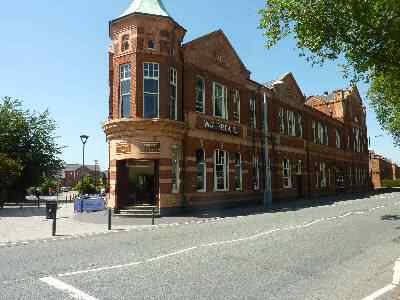
The Railway Institute was founded as a result of a group of employees of the Midland Railway setting up a Reading Society in 1850. The present building dates back to 1892 when the decision was made to remove several houses to accommodate the new cultural centre for railway workers. In addition to the library, there were several other rooms set on one side for recreation, including a lecture and concert hall, billiards room, classrooms and a coffee room.
By the 1980s, the Railway Institute had been leased off to the Post Office Social Club, but that closed in 1994. Following the failure of plans to convert it into an arts centre, it was opened as a pub in 1996, called The Waterfall. The modernised building also incorporates conference and banqueting facilities as well as the café-bar. Currently, a redevelopment of the site is planned.
The two smaller squares, Leeds Place and Sheffield Place continue the railway theme as they were named after cities on the line. This was the first development of its kind in the country and when, in 1970, it was decided to demolish it, there was strong opposition to the plan. Derbyshire Historic Buildings Trust stepped in with a modernisation programme and the Council dropped their proposals.
The Brunswick Inn was opened in 1842 and intended for the use of railwaymen and second-class passengers. After a long period of inactivity, the Brunswick re-opened in 1987, following restoration work undertaken on behalf of the Derby Civic Society and the Derbyshire Historic Buildings Trust. Four years after purchasing the pub in 1987, Trevor Harris the owner established a brewery on the premises. Since then, the pub has won several notable awards.
The Victoria Inn

The Victoria Inn, or ‘Vic’, is a 150-capacity music venue and public house, just across the road from the railway station. Many up-and-coming bands and musicians who have performed at the ‘Vic’ have gone on to become very successful in the music business. The walls of the bar are covered with band photographs and concert posters depicting the long history of the bands that have performed in the music venue at the back of the pub.
For lovers of rock, punk, grunge and metal, this is the ultimate place to hear the next band before they break into mainstream.
Waterfall
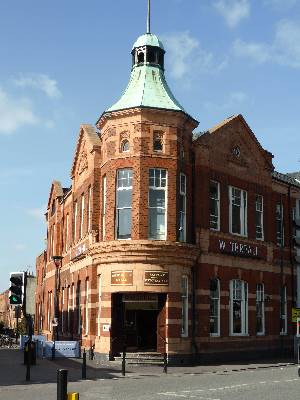
The Waterfall was opened as a pub in 1996, in the former Midland Railway Institute Building, which was built in 1892. In the years following the acquisition, the pub has refurbished the premises to include a bar and cafe, an American Pool Lounge, two function rooms and an Executive Bar. It claims to be ‘the ultimate party venue in Derby’ and caters for Weddings, Birthday Parties, Anniversaries, Children’s Parties, Christenings, Office Parties and Christmas Parties. A redevelopment of the facilities is planned
The former Railway Institute
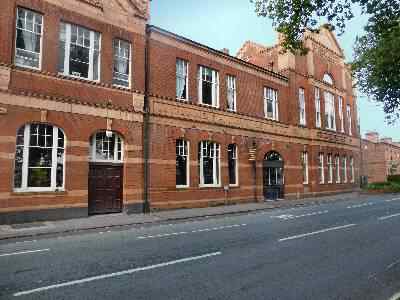
Just over ten years after the arrival of the railway, the Railway Institute was founded for Midland Railway employees. The impressive red brick Institute building was erected in 1892, with its name spelt out in terracotta facing bricks, facing onto Railway Terrace. Opened on 16 February 1894, as a cultural centre for railway workers, it at one time contained a library of 18,000 books, a concert hall with a stage and a sitting for 500 people. Also, there were several other rooms set on one side for dining, meetings and games. It is now a pub called The Waterfall.
Railway Terrace Cottages
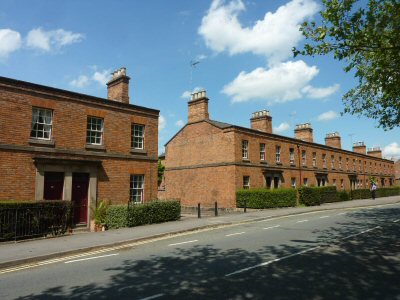
To accommodate the more senior Midland Railway staff, Jackson and Thompson built a triangular block of streets called North Street (now Calvert Street), Midland Place and Railway Terrace. The initial letter from the three streets results in NMR, which stands for North Midland Railway. All the railway cottages are still occupied, following a successful campaign in the 1970s against demolition.
The Brunswick Inn

Designed by Francis Thompson and built for the use of railwaymen and second-class passengers, it was opened in 1842 and is one of, if not the earliest examples of a purpose-built commercial inn in the country. Originally it was called ‘The Brunswick Railway and Commercial Inn’ and remained in the ownership of the railways for 105 years.
After a long period of inactivity, the pub was rescued from the threat of demolition. Great care was taken to keep everything in keeping with the history of the Inn, which now has its own brewery. The production of beer was begun on 11 June 1991. Since then, the Brunswick Brewing Company has established itself up and down the country and has collected many awards for its ale, from local festival awards to national recognition.
Branch of Derby Canal
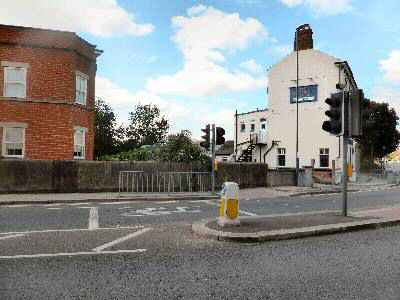
The wall by the road between the Alexandra and the Brunswick Inn identifies where a branch of the former Derby Canal once ran to provide a waterborne service to industries in the Wellington Street area. In November 2015, builders working on the Castleward scheme unearthed a section of the canal. The building project will eventually create 800 new homes between Derby Railway Station and the main shopping centre.
In ancient times the River Derwent had been used for transport from the Trent, but it was winding and shallow in many places and silt was a constant problem. The Trent was a little better. James Brindley, the great canal builder, had planned to link the Trent and Mersey Canal with Derby but was prevented from doing so by vested interests. As a result nothing further happened until Benjamin Outram was eventually commissioned to build the canal, which was completed in 1796, providing Derby with a reliable water transport system. The canal ran from the Trent and Mersey Canal at Swarkestone to Derby and Little Eaton, and the Erewash Canal at Sandiacre.
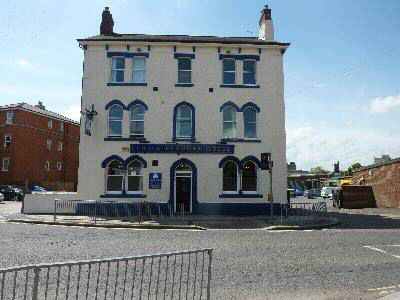
Alexandra Hotel
In 1841/2 Siddals Road was extended to connect with Railway Terrace to improve access to the Railway Station. The Alexandra Hotel, near the new Pride Park flyover, was built around 1890. The award-winning pub is named after HRH Princess Alexandra, the Danish princess who married the future Edward VII on 10 March 1863. In 1974, it became the birthplace of Derby CAMRA (The Campaign for Real Ale), but despite this was closed for demolition in 1987. For two years it remained boarded up before being rescued by Bateman’s Brewery. The pub has a railway heritage theme and the bar is adorned with railway memorabilia. Accommodation is available.
Railway Bridge over the River Derwent
This Five Arches railway bridge dates back to 1839 when the bridge was constructed. It crossed the River Derwent to the north of the station and was paid for by the North Midland Railway, and remains in use today. The girder bridge over the former Derby Canal paid for by the Midland Counties Railway, is now dominated by the modern road viaduct carrying Pride Parkway over the railway.
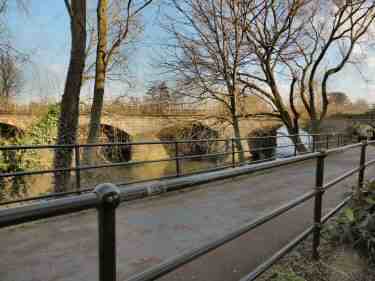
The Bass Recreation Ground
Michael Thomas Bass, MP for Derby from 1848 to 1883 was a generous local benefactor. He gave the land to the town in 1867, on which the Bass Recreation Ground now stands. Bass had purchased the three-acre site, bounded by the River Derwent and Morledge mill stream. The area was formerly known as ‘The Holmes’. In 1866, it became Derby’s second park. The open-air swimming baths on the site comprised two baths, measuring 100ft x50ft and 129 dressing cubicles. Bass hired George Thompson as the architect for the complex, which eventually cost him £2,500, in addition to the £3,850 he paid for the recreation ground. The baths opened in 1873 and were demolished after the Second World War.
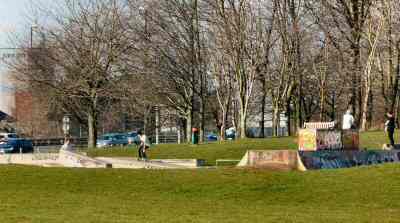
The land is now used for events and a skate park has been built near the Inner Ring Road. The path close to the river is in regular use by walkers and cyclists and links up with the River Gardens.
Site of the former Signal Works
The Midland Railway established a Signal Works in 1871. Located on a narrow strip of land between the Derby and Sheffield mainline and the River Derwent, the building looks southeast across the river towards the Bass Recreation Ground. The works were closed when production was transferred to Crewe, in 1932.
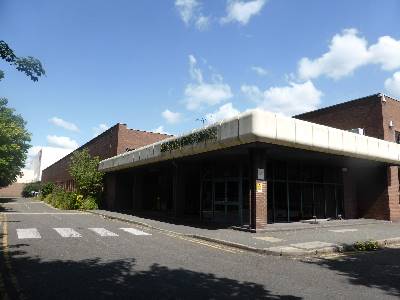
In the mid-1970s plans were completed for the new Northcliffe House to take over the site and from the end of 1979 departments of the paper began to move to the new site. There was though a problem, as negotiations for the change of working conditions were not yet complete with one production union, and the paper found itself in its new home but unable to publish. In the week it took for the agreement to be reached; only some emergency bulletins were published. On 9 February 1981, the first edition of the Derby Evening Telegraph was printed at its new home.
Now known simply as the Derby Telegraph, the paper operates from 2 Siddals Road, Derby. The move took place in November 2014 and brought the paper much closer to the City Centre.
Pride Park
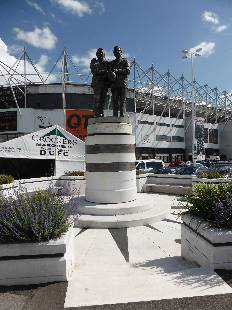
Before Pride Park was converted into a very successful business park, it had lain derelict for many years. The land previously had been used by the railway industry as well as providing space for gas works and several other industries. It was badly contaminated and required extensive redevelopment, which took over ten years to reclaim and included the building of a new access road.
Over the last twenty years, Pride Park has developed into one of the most important business and commercial property destinations in the East Midlands. Approximately one million square feet of space has been developed and little space remains available, apart from the area known as the ‘Triangle’ a 50-acre site that adjoins Pride Park, which is scheduled for redevelopment.
Following on from the success of Pride Park, a £200 million high-tech business park is under construction between Sinfin and Chellaston which when complete will be even bigger. Known as Infinity Park it will aim to build upon the city’s prowess for cutting-edge ideas, particularly within the aerospace, automotive and transport industries.
Pride Park Football Ground
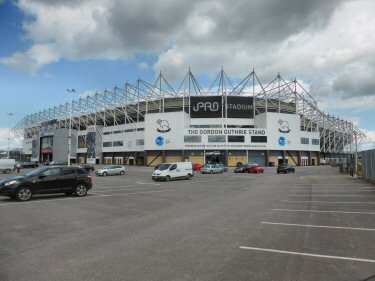
In 1993 plans were drawn up for Derby County to move to Pride Park, but this did not come about as originally planned. The football club decided to remain, where it was and redevelop the Baseball Ground. However, in a dramatic last-minute move, with work scheduled to start within a few days, the club had second thoughts and reopened talks about moving to Pride Park. Derby County Football Club’s impressive stadium originally named Pride Park was later renamed the iPro Stadium, but this is no longer the case. The Stadium forms the centrepiece of the development.
The stadium was opened by HM the Queen, on 18th July 1997. Unfortunately, the first league match at the stadium, against Wimbledon FC, ended in embarrassment when the match had to be abandoned due to floodlight failure. Representative football came to Pride Park for the first time in February 1999 when England under 21s played the French under 21 team. This was followed in May 2001 by a full-international match, England versus Mexico, played in front of what was, at the time, a record crowd for the stadium.
Derby Arena
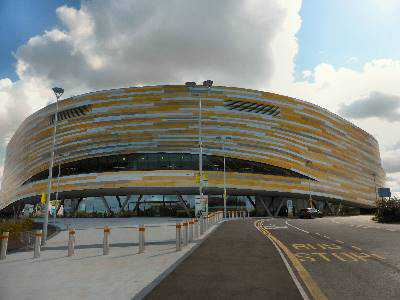
The Arena provides a venue for sporting events as well as exhibitions, concerts, product launches and conferences. It can accommodate up to 5,000 people for special events, with some seated and others standing.
The 250m indoor cycle track is suitable for individual, club, school, group and business track sessions, track leagues, and local, regional, national and international track events. The cycle track itself is made out of Siberian Spruce and designed by Velotrack. Derby Arena’s cafe, Café 42, is an excellent place to take refreshments and at peak periods to watch cyclists riding the track in the background.
The Sanctuary
At the rear of Derby Arena on Pride Park is ‘The Sanctuary’ a bird and wildlife reserve. It was formerly a gas works tip and had long been protected from development as part of the ‘green wedge’ policy of Derby City Council. However, it was not until 2001 that the importance and potential of this site were fully appreciated. When the work to create the Pride Park business site came to a close.
The site has deliberately been kept quite bare and devoid of trees, which attracts birds like the skylark, meadow pipit, the common tern and many other species. Access is not possible onto The Sanctuary itself, without special permission. All main features can be easily viewed from several points around the perimeter fencing, all accessible from the car park. Take your binoculars along and see what you can spot.
